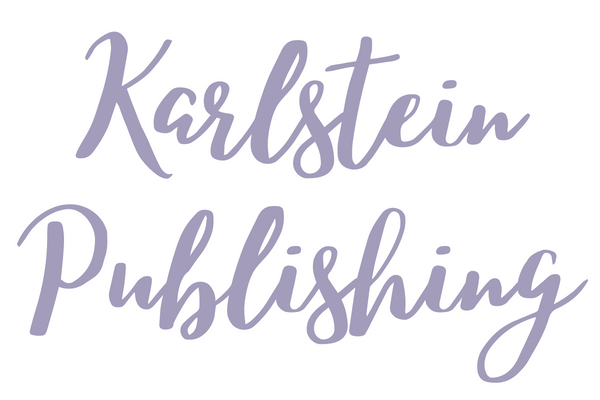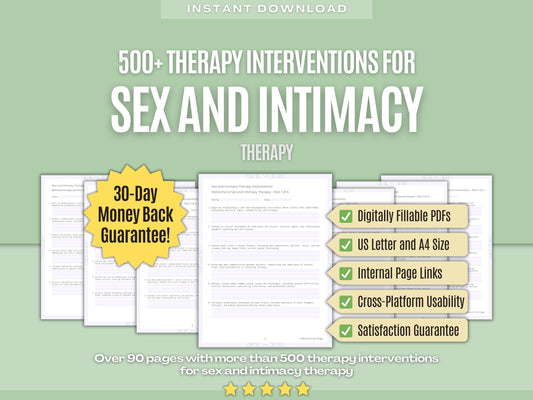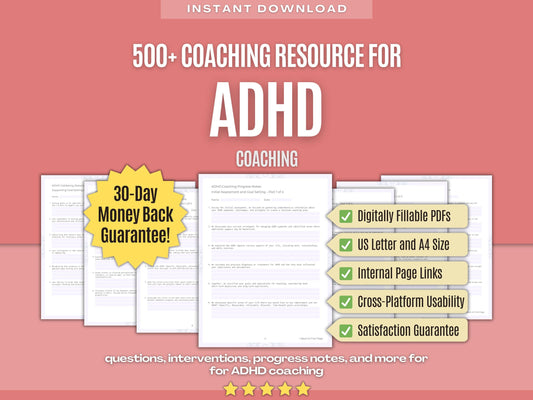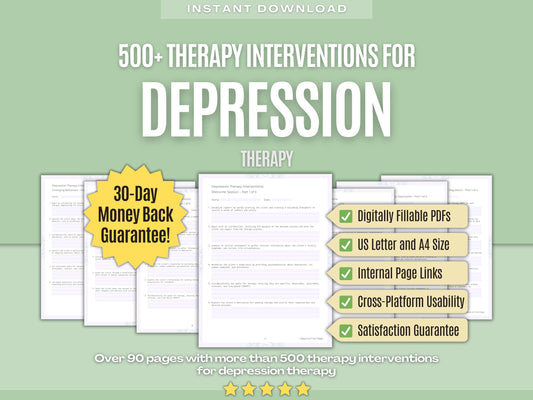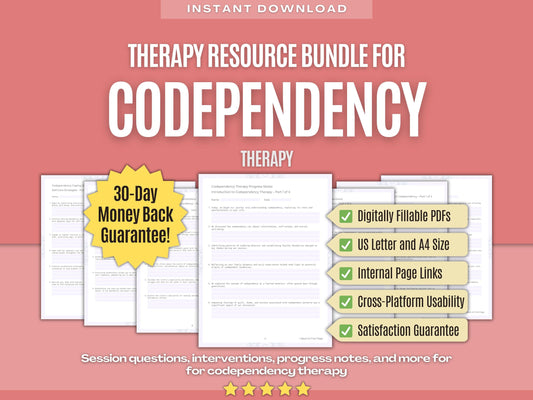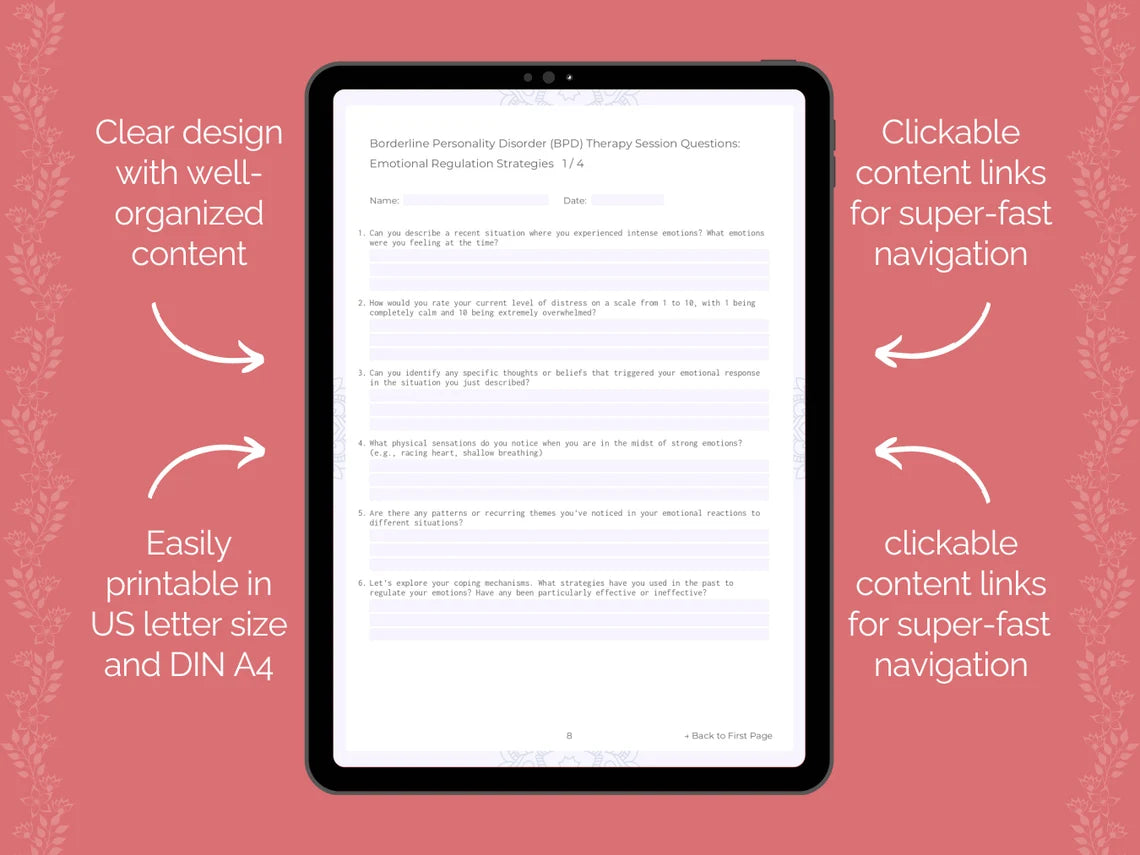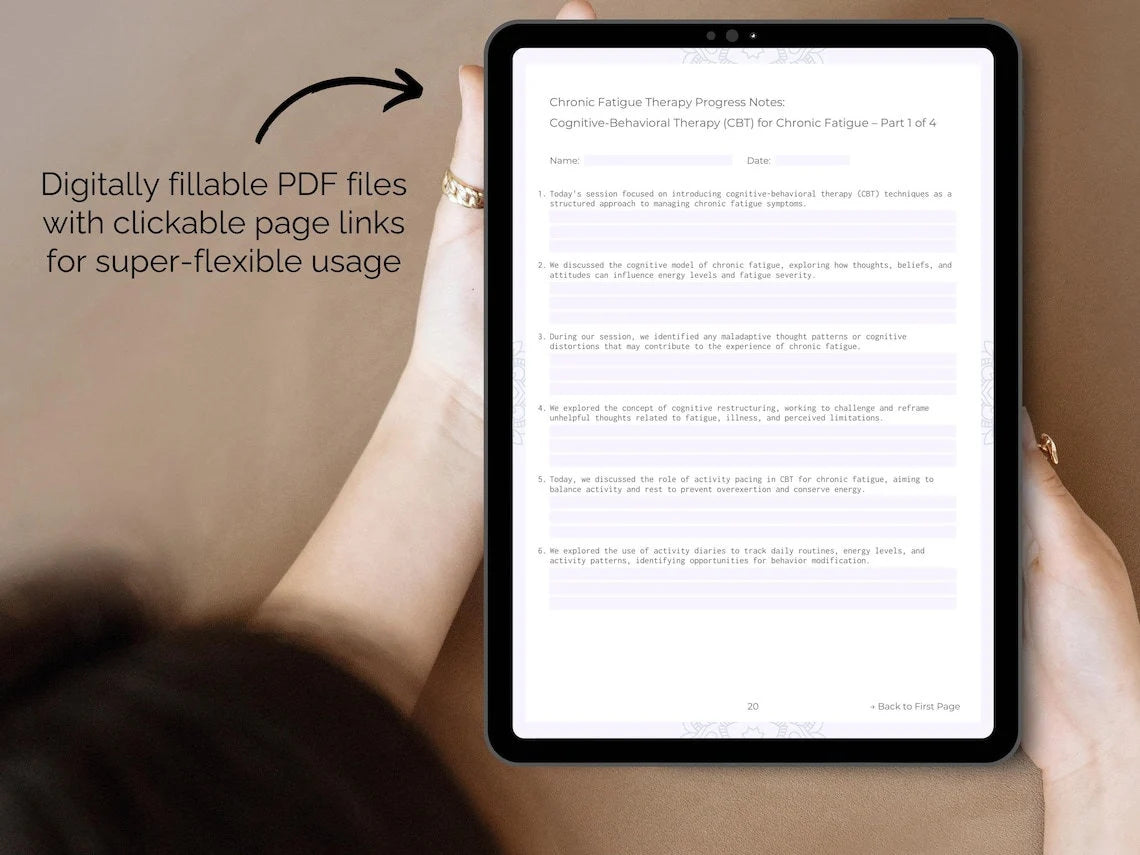Elevate Your Therapy and Guide Your Clients to Inner Healing with Our Autism Spectrum Disorder Coping Skills! ✨
1. Celebrating Your Unique Strengths
- Reflect on past accomplishments and challenges overcome, recognizing the resilience and strength demonstrated in navigating life with autism.
- Engage in self-expression through creative outlets such as art, music, writing, or drama, embracing the opportunity to communicate and connect with others in meaningful ways.
- Practice self-compassion by acknowledging and accepting both strengths and areas for growth, fostering a sense of kindness and understanding towards oneself.
- Embrace neurodiversity as a concept that celebrates the variety of neurological differences present in the world, recognizing the value of diverse perspectives and ways of being.
- Share personal experiences and insights with others, contributing to greater understanding and acceptance of autism while fostering connections and community.
- Practice positive self-talk and affirmations that acknowledge and celebrate unique qualities and achievements, cultivating a mindset of self-confidence and worthiness.
- Foster social connections with peers who appreciate and value individual strengths, providing opportunities for mutual support, validation, and camaraderie.
- Cultivate a sense of purpose and meaning by identifying ways to contribute to causes or communities that resonate with personal values and strengths.
- Advocate for accommodations and supports that recognize and capitalize on strengths, promoting access, inclusion, and success in various environments.
- Explore and embrace personal identity beyond the label of autism, recognizing that strengths and interests are integral parts of a multifaceted individual.
- Participate in peer support groups or online communities where individuals with autism can share experiences, insights, and strategies for embracing strengths.
Need more? Find all 500+ Coping Skills for Autism Spectrum Disorder Therapy in our Digital Workbook!
2. Navigating Sensory Sensitivities
- Identify specific sensory triggers or sensitivities, such as loud noises, bright lights, or certain textures, to better understand individual sensory experiences.
- Practice deep breathing exercises or progressive muscle relaxation techniques to promote relaxation and reduce the physiological response to sensory overload.
- Create a sensory-friendly space at home or work by minimizing clutter, controlling lighting, and incorporating soothing elements like soft fabrics or natural textures.
- Develop a sensory diet consisting of activities that provide calming or organizing sensory input, such as swinging, rocking, or deep pressure activities, to regulate arousal levels throughout the day.
- Advocate for accommodations in various settings, such as adjusting lighting or seating arrangements, to minimize sensory challenges and promote accessibility.
- Practice mindfulness techniques to increase awareness of sensory experiences without judgment, allowing for greater self-regulation and acceptance of sensory sensitivities.
- Seek out sensory-friendly activities and environments that accommodate individual sensitivities, such as quiet spaces or sensory-friendly events, to participate in leisure and social activities comfortably.
- Engage in sensory exploration and desensitization activities to gradually expose oneself to challenging stimuli in a controlled and supportive manner, building tolerance over time.
- Utilize distraction techniques, such as listening to music, focusing on a preferred activity, or using handheld sensory tools, to redirect attention away from distressing sensory stimuli.
- Educate others about sensory sensitivities and autism to promote understanding, empathy, and inclusive practices in various environments.
- Practice self-care strategies that prioritize sensory comfort and relaxation, such as taking warm baths, receiving massages, or spending time in nature.
Need more? Find all 500+ Coping Skills for Autism Spectrum Disorder Therapy in our Digital Workbook!
3. Developing Social Skills
- Practice active listening skills by maintaining eye contact, nodding, and summarizing what others have said to demonstrate understanding and engagement in conversations.
- Seek out opportunities for structured social interactions, such as group therapy sessions, social skills groups, or community-based activities, to practice social skills in a supportive environment.
- Utilize visual supports, such as cue cards or emotion charts, to help identify and express emotions accurately during social interactions.
- Practice assertiveness skills by expressing thoughts, feelings, and opinions respectfully and assertively, while also being mindful of others' boundaries and perspectives.
- Develop strategies for managing social anxiety or sensory sensitivities in social settings, such as deep breathing exercises or visualization techniques to promote relaxation and confidence.
- Use social scripts or conversation starters to initiate interactions and keep conversations going, particularly in unfamiliar or challenging social situations.
- Seek feedback from trusted friends, family members, or therapists to identify areas for improvement in social skills and develop personalized strategies for growth.
- Utilize social media and online forums to practice social skills and connect with peers who share similar interests, hobbies, or experiences.
- Practice reciprocity in social relationships by offering help, support, and encouragement to others, building trust and rapport over time.
- Seek out opportunities for social inclusion and participation in community events, clubs, or organizations that celebrate diversity and promote acceptance.
- Engage in activities that foster social confidence and self-esteem, such as public speaking, performing arts, or volunteering in leadership roles.
Need more? Find all 500+ Coping Skills for Autism Spectrum Disorder Therapy in our Digital Workbook!
4. Building Routines for Comfort and Security
- Establish a consistent daily schedule that includes regular mealtimes, bedtime routines, and designated times for activities such as work, leisure, and self-care.
- Incorporate sensory-friendly elements into daily routines, such as using soft lighting, comfortable clothing, or preferred textures, to enhance comfort and reduce sensory overwhelm.
- Practice time management skills by allocating specific time blocks for different activities or tasks, and use timers or alarms as reminders to stay on track.
- Use transitional objects or rituals, such as a favorite toy or specific sequence of actions, to facilitate smooth transitions between activities or environments.
- Establish boundaries around work, leisure, and rest times to prevent overstimulation, burnout, or exhaustion, and prioritize self-care and relaxation.
- Involve family members or caregivers in establishing and maintaining daily routines to promote consistency, collaboration, and support in achieving shared goals.
- Create designated spaces or stations for specific activities or tasks, such as a work desk, relaxation corner, or sensory-friendly area, to enhance organization and accessibility.
- Practice flexibility and adaptability within routines by incorporating backup plans or alternative strategies for unexpected changes or disruptions.
- Practice relaxation techniques such as mindfulness, meditation, or progressive muscle relaxation as part of daily routines to promote stress reduction and emotional well-being.
- Use social reinforcement and positive feedback to acknowledge and reinforce adherence to routines, promoting motivation, self-esteem, and sense of accomplishment.
- Establish clear boundaries and limits around screen time and digital devices within daily routines to promote balance, healthy habits, and sleep hygiene.
Need more? Find all 500+ Coping Skills for Autism Spectrum Disorder Therapy in our Digital Workbook!
5. Establishing Healthy Relationships
- Practice active listening during conversations to demonstrate your interest and understanding of others' perspectives.
- Seek out support groups or therapy sessions specifically tailored for individuals with Autism Spectrum Disorder to connect with peers who understand your experiences.
- Set boundaries and communicate your needs clearly and assertively in relationships to maintain a healthy balance.
- Practice empathy by considering others' feelings and perspectives, even if they differ from your own.
- Seek guidance from a therapist or counselor to navigate social nuances and develop effective communication skills.
- Create a support network of friends, family members, or mentors who can provide encouragement and guidance in building healthy relationships.
- Explore online communities or forums where you can connect with others who share similar interests and experiences.
- Practice reciprocity in relationships by offering support and kindness to others as well as accepting help when needed.
- Seek opportunities for socialization in structured environments such as classes, clubs, or volunteer activities where shared interests can facilitate connections.
- Use social cues such as body language and facial expressions to interpret and respond appropriately to social cues.
- Build self-confidence by focusing on your strengths and accomplishments in social interactions.
Need more? Find all 500+ Coping Skills for Autism Spectrum Disorder Therapy in our Digital Workbook!
6. Improving Attention and Focus
- Break tasks into smaller, more manageable steps to prevent feeling overwhelmed and maintain focus on one aspect at a time.
- Create a designated workspace free from distractions, clutter, and excessive noise to promote concentration and productivity.
- Use timers or alarms to allocate specific time intervals for tasks, alternating between periods of focused work and short breaks to prevent mental fatigue.
- Engage in physical activity or movement breaks to stimulate circulation, increase alertness, and improve concentration.
- Experiment with different study or work environments to identify optimal conditions for concentration, such as natural lighting, comfortable seating, or background music.
- Break longer tasks into shorter intervals with built-in rewards or incentives for meeting milestones, providing motivation and reinforcement for sustained attention.
- Develop strategies for managing impulsivity and intrusive thoughts, such as visualization techniques or cognitive reframing, to redirect attention back to the task at hand.
- Use organizational tools, such as planners, calendars, or digital apps, to keep track of deadlines, appointments, and commitments, reducing cognitive load and facilitating better attention management.
- Practice active listening skills during conversations or lectures, using techniques such as paraphrasing or summarizing to reinforce comprehension and retention of information.
- Implement strategies for improving working memory, such as mnemonic devices or chunking information, to enhance retention and recall of relevant details.
- Limit exposure to digital distractions, such as social media or email notifications, by setting boundaries and scheduling designated times for checking devices.
Need more? Find all 500+ Coping Skills for Autism Spectrum Disorder Therapy in our Digital Workbook!
7. Strategies for Independence
- Break tasks into smaller steps to make them more manageable and approachable, allowing for a sense of accomplishment as each step is completed.
- Utilize visual schedules or checklists to outline tasks and responsibilities, providing clear guidance and direction for completing them independently.
- Set realistic goals for increasing independence in specific areas of life, such as self-care, household tasks, or social interactions, and work towards achieving them gradually.
- Develop strategies for managing time effectively, such as using timers or alarms to stay on track with tasks and appointments.
- Use technology-based tools and apps to assist with organization, communication, and daily tasks, such as reminder apps, task managers, or virtual assistants.
- Develop strategies for managing finances responsibly, such as budgeting, saving, and tracking expenses, to promote independence and financial stability.
- Develop strategies for managing sensory sensitivities or environmental triggers that may impact daily functioning and independence, such as noise-canceling headphones or relaxation techniques.
- Seek out opportunities for vocational training, job skills development, or volunteer work to build job readiness skills and increase independence in the workplace.
- Practice social skills and communication techniques to navigate social interactions and build meaningful relationships with others.
- Seek out mentors or role models who can provide guidance, support, and encouragement in developing independence and achieving personal goals.
- Practice self-reflection and self-awareness to identify strengths, weaknesses, and areas for growth in developing independence and autonomy.
Need more? Find all 500+ Coping Skills for Autism Spectrum Disorder Therapy in our Digital Workbook!
8. Advocating for Yourself
- Develop self-awareness of your needs, preferences, strengths, and challenges to effectively advocate for yourself in various situations.
- Educate yourself about your rights and entitlements in different contexts, such as school, work, healthcare, or social services, to ensure you receive appropriate support and accommodations.
- Identify trusted allies, such as family members, friends, teachers, counselors, or mentors, who can provide guidance, encouragement, and support in advocating for yourself.
- Use visual aids, written notes, or scripts to assist with communication and ensure clarity and understanding when advocating for yourself, particularly in unfamiliar or stressful situations.
- Practice active listening skills to understand others' perspectives, concerns, and needs, and use this information to inform your own advocacy efforts and negotiate mutually beneficial solutions.
- Seek out opportunities for leadership roles, advocacy groups, or community organizations where you can contribute your voice and perspective to broader social issues and initiatives.
- Use social media platforms or online forums to connect with others who share similar experiences or concerns, and to raise awareness and advocate for important issues related to autism spectrum disorder.
- Develop skills for managing emotions and stress in advocacy situations, such as deep breathing, mindfulness, or grounding techniques, to stay calm and focused under pressure.
- Document important information, correspondence, or interactions related to advocacy efforts, such as emails, phone calls, or meeting notes, to track progress and maintain records for future reference.
- Stay informed about changes in laws, policies, or regulations that may affect your rights or access to services, and advocate for necessary reforms or improvements to support individuals with autism spectrum disorder.
- Celebrate achievements and milestones in advocating for yourself, recognizing the progress made and the positive impact of your efforts on your own life and the lives of others.
Need more? Find all 500+ Coping Skills for Autism Spectrum Disorder Therapy in our Digital Workbook!
9. Nutrition and Exercise for Well-being
- Establish a balanced and nutritious diet that includes a variety of foods from different food groups, such as fruits, vegetables, whole grains, lean proteins, and healthy fats, to support overall health and well-being.
- Experiment with meal planning and preparation to ensure access to nutritious meals and snacks throughout the day, even during busy or stressful times.
- Incorporate regular physical activity into your daily routine, such as walking, jogging, cycling, swimming, or yoga, to promote physical fitness, reduce stress, and improve mood.
- Set realistic fitness goals and track progress over time, celebrating achievements and milestones along the way to stay motivated and focused on maintaining an active lifestyle.
- Seek out social support and accountability by exercising with friends, family members, or support groups, which can increase motivation and adherence to regular physical activity.
- Incorporate strength training exercises, such as weightlifting or bodyweight exercises, into your fitness routine to build muscle mass, improve bone density, and boost metabolism.
- Practice self-care activities such as taking warm baths, getting massages, or practicing gentle stretching exercises to relax muscles and alleviate tension after intense workouts.
- Engage in mindful movement practices such as tai chi or qigong to cultivate awareness, balance, and inner peace while improving physical fitness.
- Prioritize sleep and rest to allow your body time to recover and repair from physical activity, as adequate sleep is essential for overall health and well-being.
- Incorporate relaxation techniques such as progressive muscle relaxation, guided imagery, or aromatherapy into your bedtime routine to promote restful sleep and improve sleep quality.
- Seek out professional guidance from registered dietitians, nutritionists, personal trainers, or fitness instructors who can provide personalized advice and support for achieving health and fitness goals.
Need more? Find all 500+ Coping Skills for Autism Spectrum Disorder Therapy in our Digital Workbook!
10. Celebrating Achievements and Setting New Goals
- Reflect on past achievements, no matter how big or small, to acknowledge progress and growth over time.
- Celebrate achievements with loved ones, friends, or support groups who can share in your joy and offer encouragement and validation.
- Create a visual display or journal of achievements and milestones to serve as a reminder of your accomplishments and the obstacles you've overcome.
- Reflect on the skills, strengths, and qualities that helped you succeed, and consider how you can leverage these assets in future pursuits.
- Break down larger goals into smaller, more manageable steps or milestones to create a roadmap for success and maintain motivation and momentum.
- Practice self-compassion and patience when facing setbacks or obstacles on the path to achieving new goals, recognizing that setbacks are a natural part of the learning and growth process.
- Engage in positive self-talk and affirmations to cultivate confidence, optimism, and a belief in your ability to overcome obstacles and achieve your goals.
- Seek out support and accountability from peers, mentors, or support groups who can provide encouragement, guidance, and motivation in pursuing new goals.
- Practice self-monitoring and reflection on progress towards new goals, adjusting strategies or approaches as needed to stay aligned with objectives and priorities.
- Share your goals with others who can offer support, encouragement, and accountability in pursuing them, fostering a sense of connection and collaboration.
- Cultivate a growth mindset by viewing challenges and failures as opportunities for learning and improvement, rather than as reflections of personal shortcomings or limitations.
We hope that our coping skills for Autism Spectrum Disorder therapy will help you to elevate your therapy practice and guide your clients to inner healing! Do you need more coping skills for Autism Spectrum Disorder therapy? Find them all in our Digital Workbook! Or do you have any questions or suggestions for us? Please feel free to contact us at any time!
